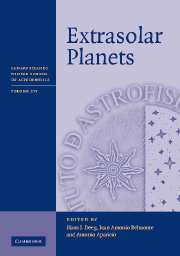Book contents
- Frontmatter
- Contents
- List of contributors
- List of participants
- Preface
- Acknowledgements
- 1 Overview of extrasolar planet detection methods
- 2 Statistical properties of exoplanets
- 3 Characterizing extrasolar planets
- 4 From clouds to planet systems: formation and evolution of stars and planets
- 5 Abundances in stars with planetary systems
- 6 Brown dwarfs: the bridge between stars and planets
- 7 The perspective: a panorama of the Solar System
- 8 Habitable planets around the Sun and other stars
- 9 Biomarkers of extrasolar planets and their observability
- References
3 - Characterizing extrasolar planets
Published online by Cambridge University Press: 10 August 2009
- Frontmatter
- Contents
- List of contributors
- List of participants
- Preface
- Acknowledgements
- 1 Overview of extrasolar planet detection methods
- 2 Statistical properties of exoplanets
- 3 Characterizing extrasolar planets
- 4 From clouds to planet systems: formation and evolution of stars and planets
- 5 Abundances in stars with planetary systems
- 6 Brown dwarfs: the bridge between stars and planets
- 7 The perspective: a panorama of the Solar System
- 8 Habitable planets around the Sun and other stars
- 9 Biomarkers of extrasolar planets and their observability
- References
Summary
Transiting extrasolar planets provide the best current opportunities for characterizing the physical properties of extrasolar planets. In this chapter, I first describe the geometry of planetary transits, and methods for detecting and refining the observations of such transits. I derive the methods by which transit light curves and radial velocity data can be analyzed to yield estimates of the planetary radius, mass and orbital parameters. I also show how visible-light and infrared spectroscopy can be valuable tools for understanding the composition, temperature and dynamics of the atmospheres of transiting planets. Finally, I relate the outcome of a participatory lecture-hall exercise relating to one term in the Drake equation, namely the lifetime of technical civilizations.
Introduction
Finding extrasolar planets is good; learning something about their intrinsic properties is much better. Planets that are known only from their radial velocity signatures can be studied only in a limited sense: we can put a fairly reliable lower limit on their masses, and we can know the size and shape of their orbits. Transiting planets offer opportunities for more complete characterization: we can measure their radii with some precision, and in principle we can learn something of their temperature structure and of their atmospheres. For this reason, this review deals almost entirely with transiting planets. The plan of the paper is as follows: Section 3.2 introduces the basic geometrical and astrophysical ideas relating to transiting planets, and establishes the relationships among them.
- Type
- Chapter
- Information
- Extrasolar Planets , pp. 65 - 88Publisher: Cambridge University PressPrint publication year: 2007
References
- 1
- Cited by



